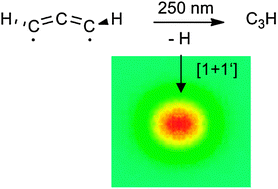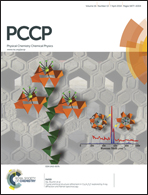Photodissociation dynamics of propargylene, HCCCH†
Abstract
We report a joint theoretical and experimental study on the photodissociation of the C3H2 isomer propargylene, HCCCH, combining velocity map imaging with nonadiabatic trajectory surface hopping calculations. Propargylene loses an H-atom, after laser excitation at around 250 nm, presumably to the T6 state. The photofragment angular distribution exhibits only a very small anisotropy, but the H-atom translational energy distribution extends to high energies and shows an expectation value of 〈fT〉, the fraction of excess energy released as translation, of 48%, outside the range expected for a statistical reaction mechanism. The computations suggest a predissociation in the T4–T6 state and lead to a translational energy distribution and photofragment angular distribution that match the experimentally observed ones very well.

- This article is part of the themed collection: Imaging molecular dynamics

 Please wait while we load your content...
Please wait while we load your content...